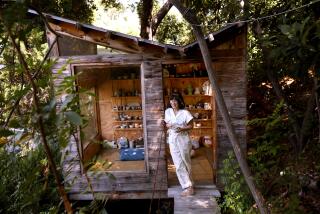All that California wildfire smoke? She’s turning it into smog art
The day after the Bobcat Fire began to blaze in Los Angeles County, Kim Abeles put five Titanic deck chairs on her roof.
That is, the artist made stencils from photographs of the deck chairs on the Titanic. She placed those cut images on pieces of scrap wood.
Abeles, 68, then laid those pieces of wood on the roof of her 100-year-old mother’s house in Pasadena, where she lives on the weekends as a caretaker.
That was in early September, and the artist planned to let the smoke, ash and particulates in the heavy air fall on that wood, collecting over time and forming an image when the stencil was removed.
Those slabs of wood are part of an ongoing series Abeles has been creating since 1987, the Smog Collectors. Usually, the Smog Collectors materialize on plates or on fabric, but the fire spread so quickly that the artist had to make do with what she had on hand.
“I scurried on that … like, what can I put these on?” Abeles told The Times. “I know my daughter’s not gonna let me use our dinner plates.”
She left out this set of Smog Collectors for one month. Her Presidential Commemorative Smog Plates, made in 1992, were left out on the roof for a length of time determined by each president’s environmental record.
President Carter, who installed solar panels on the White House, stayed out for four days. President Reagan, whom Abeles thought had a particularly lackluster environmental policy, stayed out for 40. (The series stretched from William McKinley to George H.W. Bush.)
At first, Abeles thought she might put the new wildfire batch out for just one day.
“Like, ‘Oh, here’s what one day of badness looks like,’” she said.
For her next batch of pieces, she sifted through auction records to find out that the original Titanic chairs were made of beechwood. By late September, her order of European beech had arrived.
“To me, the devil’s in the detail,” Abeles said.
“As an artist, when I feel like the materials are resonating and the idea has some intention to it, then I’m just like a dog with a bone.”
The artist considered tracing different views of the chairs on the new wood but decided against it.
“When an image is repeated like that, it becomes this iconic emblem,” she said. “It was less about my drawing skill and more about its being emblematic.”
Abeles has been working as an artist since she first came to Southern California for graduate school at UC Irvine in 1978. Since then, her art has revolved around biography, geography, feminism — and the environment.
Her work has been commissioned by the California Bureau of Automotive Repair (in 1991, when she made Smog Collectors out of mufflers and catalytic converters) and the National Park Service (in 2018, when she made “Valises for Camp Ground” with female inmate firefighters).
Working with the environment and air pollution in California on a daily basis can be draining.
“I’m frustrated most every morning I wake up,” Abeles said. “However, I also feel like this tipping point has arrived. It’s not something that’s going to happen 10 years from now. It has come.”
Before “An Inconvenient Truth,” before the climate change and global warming movement gained momentum in the U.S., Abeles sometimes felt like Chicken Little, trying to convince the world that the sky really was falling.
Art gives her something to focus on and offers some sense of relief, however temporary.
“It’s like when you’re at the dentist’s office,” Abeles said. “And you’re like, ‘Oh, this is gonna hurt.’ So you focus in on a little dot in the paneling in the top, right above you. It’s sort of like that.”
Abeles’ Titanic Smog Collectors, then, are her little dot in the paneling of wildfires sweeping the West Coast.
“It’s pretty intense,” she said of the fires, “because it’s almost emblematic of the politics.”
This wasn’t the first time, however, that she had witnessed a similar scene. The last time she saw ash fall like this, she said, was during the 1992 Los Angeles uprisings. By pure coincidence, the day before they started, she had set out a 5-by-5-foot presidential seal and Eye of Providence stencils on her roof.
Once the ash and smoke stopped falling, she said, she pulled those stencils down. Historical moments, she added, have a habit of tying into the environment.
“When the ash especially starts falling, it’s really an odd experience,” Abeles said. “Because you know it’s from these live trees. For me, it’s about this strange dissonance of this ash coming toward you. … I hate to use the word apocalyptic, but it is kind of like that.”
The artist had moved to Southern California from southeastern Ohio, where she had been living in the countryside, in a converted grain silo. Talk about culture shock.
“Moving here, I mean the smog, to me, was the most impressionable thing that was happening,” Abeles said. “I couldn’t believe that when I would mention it to people, they would convince me it was just fog rolling in. I just couldn’t believe it.”
It was that disbelief that drew Abeles for the first time to the Smog Collectors project, in 1987. She moved her studio not far from factories in downtown L.A. She had been living downtown for years, she said, when all of a sudden, she saw the San Gabriel Mountains appear for the first time through the smog.
“I couldn’t believe it,” Abeles said. “But it was this one wildly clear day like we have sometimes, where everything you see just looks like something odd, because it’s just a vision that is not your daily understanding of your surroundings.”
The first Smog Collector depicts a wedge of the San Gabriel Mountains: The street makes the stencil flat on the bottom, buildings make it a rectangle on the sides and the top features the ridges of the mountains peeking through.
After that first clear day, Abeles waited to see the mountains peer through the smog just as distinctly. It took one year and two months.
She doesn’t believe her creative acts exist in “a bubble or a vacuum.”
“I’ve seen people affected by stuff, like new ways of thinking, or new angles to contemplate,” Abeles said. “None of us are making propaganda here. But we do want to open people up to maybe a different viewpoint than they could have imagined before.”
More to Read
The biggest entertainment stories
Get our big stories about Hollywood, film, television, music, arts, culture and more right in your inbox as soon as they publish.
You may occasionally receive promotional content from the Los Angeles Times.











